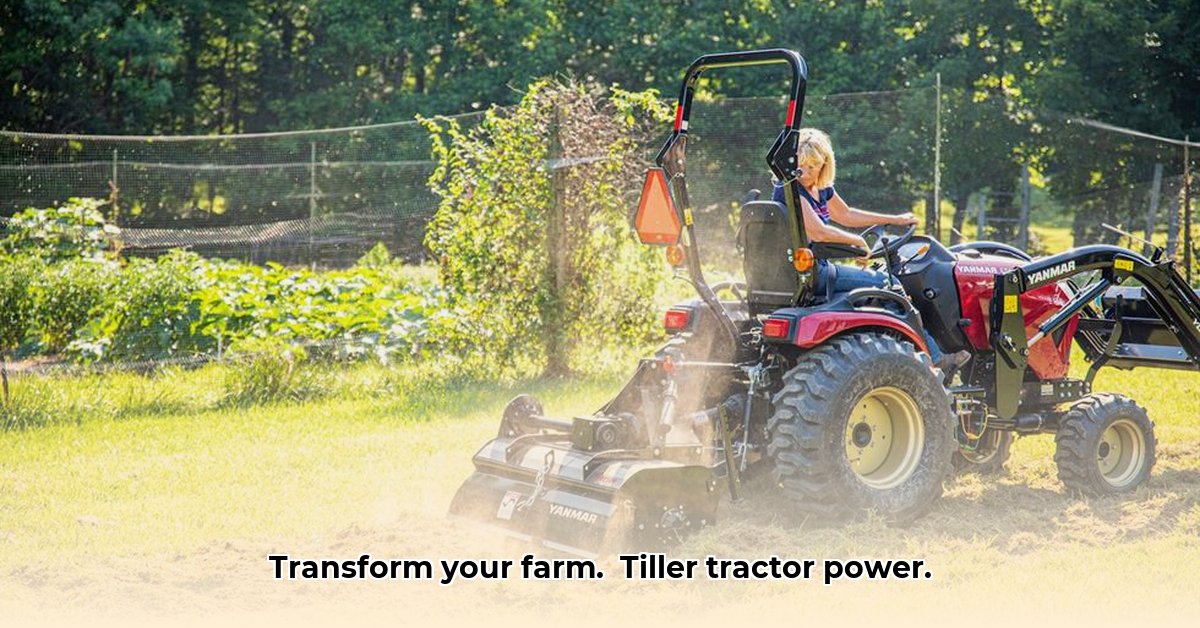
Choosing the right garden tiller for your tractor is a critical investment impacting your farm's efficiency, soil health, and overall yield. This guide helps you select the perfect tiller, ensuring sustainable practices and a thriving harvest. For more information on rear tine tillers, check out this resource.
Understanding Your Farming Operation: A Detailed Assessment
Before selecting a tiller, thoroughly analyze your farming operation. Consider these crucial factors:
Farm Size: Are you working a few acres or hundreds? This directly influences the tiller's size and power requirements. A small tiller might suffice for a small plot, while a larger operation needs a more robust machine.
Soil Type: Sandy, clay-like, or rocky soil? Heavy clay demands a powerful tiller capable of breaking up dense clumps, unlike lighter soil which requires less intensive tilling. This directly relates to tiller horsepower and tine selection.
Crops Planted: Diverse crops have varying soil preparation needs. Some prefer finely tilled soil, while others benefit from minimal soil disruption. Consider your crops' specific requirements.
Tractor Horsepower: Crucially important! A tiller must match your tractor's capability. Using a heavy-duty tiller with a low-horsepower tractor is inefficient and can damage both. Always check the tiller’s horsepower requirements.
Types of Tractor-Mounted Tillers: A Comparative Overview
Several types of tractor-mounted tillers cater to various needs and soil conditions:
Offset Tillers: Excellent for working close to obstacles (fences, trees). Their design provides maneuverability in tight spaces, making them ideal for precise tilling near obstacles.
Rear-Mounted Tillers: Versatile workhorses perfect for larger fields where speed and efficiency are paramount over precision maneuvering. They are the common choice for larger farms needing efficient tillage.
Rotary Tillers: Best for breaking up compacted soil efficiently. Their spinning blades pulverize soil, creating optimal seedbeds. They are effective in breaking apart severely packed or hard-to-till land.
Choosing the Right Tiller: Key Features and Considerations
When comparing tillers, focus on these essential aspects:
Tilling Depth: How deep should you till? Excessive depth can disrupt soil structure, leading to erosion and water loss. Aim for a depth sufficient for your crops; less is more in sustainable agriculture.
Working Width: This is the width covered in a single pass. A wider tiller reduces pass number, saving time and fuel. However, wider tillers may be less maneuverable.
Construction Material: Durability is paramount. Look for high-quality materials built to withstand years of farming.
Ease of Maintenance: A tiller is a long-term investment. Choose one easy to clean, lubricate, and repair, minimizing downtime.
Price: Assess the initial and long-term costs, factoring in maintenance and fuel consumption. A more expensive, durable tiller might prove more economical in the long run.
Sustainable Tillage: Harmony Between Farming and Environmental Stewardship
Sustainable agriculture increasingly prioritizes minimal or no-till farming. These practices minimize soil disturbance, promoting better soil structure, reduced erosion, and improved water retention. Excessive tillage can release carbon, depleting soil nutrients and negatively impacting the environment; reducing tillage depth is a key element of sustainable agriculture.
"Minimizing tillage is crucial for soil health and long-term farm sustainability," says Dr. Emily Carter, Soil Scientist at the University of California, Davis. "Choosing a tiller that allows for precise control over soil disruption is vital for environmentally responsible farming."
A Step-by-Step Guide to Selecting Your Tiller
Assess your farm's needs: Consider farm size, soil type, crops, and tractor capabilities before proceeding with selection.
Research tiller types: Understand the strengths and weaknesses of offset, rear-mounted, and rotary tillers.
Compare key features: Analyze tilling depth, working width, construction material, maintenance requirements, and price.
Read reviews: Gather insights from other farmers about tiller performance and reliability.
Visit dealerships: Examine different models in person, if possible; this allows for hands-on evaluation.
By carefully considering these steps, you can choose a tiller that enhances farm efficiency while promoting sustainable agricultural practices. Remember, your choice has a direct impact on your crops, your soil, and the environment. Invest wisely.